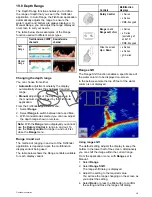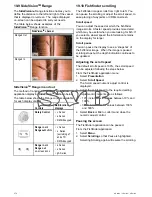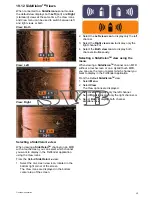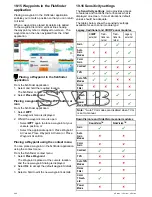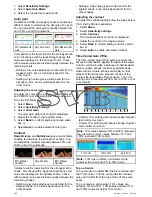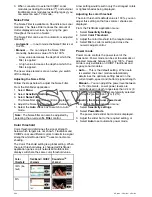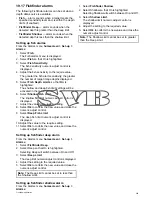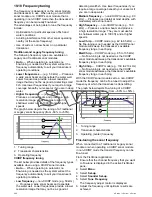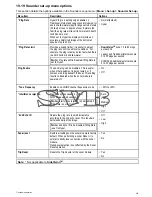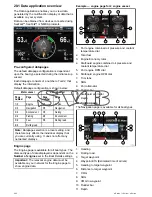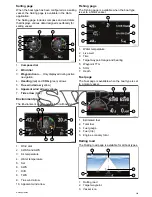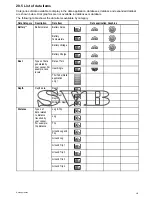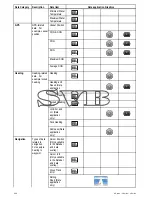
19.18 Frequency tuning
The frequency is dependent on the sonar module
and transducer in use. When using a non-CHIRP
sonar module or a CHIRP sonar module that is
operating in non-CHIRP mode then the transducer’s
frequency can be manually fine-tuned.
The advantages of being able to tune the frequency
include:
• Optimization for particular species of fish and
water conditions.
• Avoiding interference from other sonar operating
nearby (at the same frequency).
• Use of wide or narrow beam on a particular
transducer.
Traditional and Legacy frequency tuning
The following frequency types are available on
Legacy and Traditional sonar modules:
•
Auto
— When operating in automatic no
fine-tuning is needed as the system will set the
frequency automatically to suit your transducer’s
operating conditions.
•
Lower frequencies
— (e.g. 50 kHz) — Produces
a wide sonar beam and penetrate the water well.
Lower frequencies provide a lower resolution
image that may not be as good at detecting small
fish. Use lower frequencies if you require a large
coverage beneath your vessel or if you are in deep
water.
•
Higher frequencies
— (e.g. 200 kHz) —
Produces a narrow beam and produce a high
resolution image. They are most useful in
shallower water (up to 1000 ft) and at higher
speeds.
The graph below depicts fine-tuning of a Traditional
or Legacy sonar frequency (from –50% to +50%).
Low
High
S
e
n
s
it
iv
it
y
(d
B
)
Frequency
-50%
+50%
D12574-2
1
2
3
1.
Tuning range
2.
Transducer characteristics
3.
Operating frequency
CHIRP frequency tuning
The list below provides details of the frequency types
available when using a CHIRP sonar module.
•
Auto
— When operating in automatic no
fine-tuning is needed as the system will set the
frequency automatically to suit your transducer’s
operating conditions.
•
Low frequency
— non-CHIRP mode (e.g. 50 kHz)
— Produces a wide sonar beam and penetrate
the water well. Lower frequencies provide a lower
resolution image that may not be as good at
detecting small fish. Use lower frequencies if you
require a large coverage beneath your vessel or if
you are in deep water.
•
Medium frequency
— non-CHIRP mode (e.g. 90
kHz) — Produces good detail at most depths, with
moderately wide sonar beam.
•
High frequency
— non-CHIRP mode (e.g. 160
kHz) — Produces a narrow beam and produce
a high resolution image. They are most useful
in shallower water (up to 1000 ft) and at higher
speeds.
•
Low Chirp
— CHIRP mode (e.g. 42 to 65 kHz) —
No fine-tuning is not needed as the CHIRP sonar
module will sweep the transducer’s available
frequency range in each ping.
•
Med Chirp
— CHIRP mode (e.g. 85 to 135 kHz)
— No fine-tuning is not needed as the CHIRP
sonar module will sweep the transducer’s available
frequency range in each ping.
•
High Chirp
— CHIRP mode (e.g. 130 to 210 kHz)
— No fine-tuning is not needed as the CHIRP
sonar module will sweep the transducer’s available
frequency range in each ping.
With the CHIRP sonar module set to a non-CHIRP
mode the frequency can be fine tuned to adjust the
frequency at which the transducer is transmitting.
The graph below depicts fine-tuning of a CHIRP
broadband sonar frequency (from —50% to +50%).
Low
High
S
e
n
s
it
iv
it
y
(d
B
)
Frequency
D12575-2
3
-50%
+50%
1
2
1.
Tuning range
2.
Transducer characteristics
3.
Operating (center) frequency
Fine-tuning the sonar frequency
When connected to a Traditional or Legacy sonar
module or when operating a CHIRP sonar module
in non-CHIRP mode the transmit frequency can be
fine-tuned.
From the Fishfinder application:
1. Ensure that the channel frequency that you want
to fine-tune is displayed in the active Fishfinder
pane.
2. Select
Menu
.
3. Select
Set-up
.
4. Select
Sounder Set-up
.
5. Select
Tune Frequency
.
The frequency adjust control is displayed.
6. Adjust the frequency until optimum results are
achieved.
286
a Series / c Series / e Series
Содержание c125
Страница 2: ......
Страница 14: ...14 a Series c Series e Series ...
Страница 41: ...13 GPS receiver 14 Thermal camera 15 Wireless connection Planning the installation 41 ...
Страница 48: ...48 a Series c Series e Series ...
Страница 80: ...80 a Series c Series e Series ...
Страница 118: ...118 a Series c Series e Series ...
Страница 184: ...184 a Series c Series e Series ...
Страница 185: ...Chapter 13 Man Overboard MOB Chapter contents 13 1 Man overboard on page 186 Man Overboard MOB 185 ...
Страница 188: ...188 a Series c Series e Series ...
Страница 191: ...Chapter 15 Fuel manager Chapter contents 15 1 Fuel manager overview on page 192 Fuel manager 191 ...
Страница 206: ...206 a Series c Series e Series ...
Страница 228: ...228 a Series c Series e Series ...
Страница 290: ...290 a Series c Series e Series ...
Страница 310: ...310 a Series c Series e Series ...
Страница 340: ...340 a Series c Series e Series ...
Страница 374: ...374 a Series c Series e Series ...
Страница 422: ...422 a Series c Series e Series ...
Страница 436: ...436 a Series c Series e Series ...
Страница 462: ...462 a Series c Series e Series ...
Страница 463: ......
Страница 464: ...www raymarine com ...


